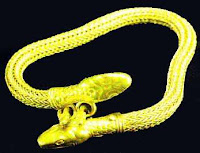First we'll talk about the Kura-Araxes Culture that existed in the southern Caucusus from around 3400 BC - 2000 BC. The culture is known by two very distinct things, both of which were so highly sought after that they spanned a large swathe of the ancient world.
First, they made very distinctive pottery. Like most early cultures we often identify a group by its style of pottery. The Kura-Araxes people made distinctive pottery that was painted with red and black geometric designs and contained Nakhichevan-type lugs, which you can surely see in these pottery shards? As far as I can tell the Nakhichevan-type lug is that circular thing you see on some of the pieces of pottery that is done in a way that is distinctive to the Kura-Araxes Culture. The pieces you see here on the left were found at a site in Iran, a place where the Kura-Araxes culture did not live.
 |
| Spear found in Gegharot, Armenia. |
So how did the Kura-Araxes' wares get from all the way north in Russia down into modern day Irsrael? Two ways. First, the Kura-Araxes had extensive trade networks allowing them to spread their goods to a far flung field. Second, they invaded areas. They began to expand their borders outward. That expansion however was abruptly stopped by someone who had been making his way into Europe for some time, but decided to begin its wave after wave of advancement at about this time that would forever change Europe.
But, the Kura-Araxes were not the only players in the Caucusus at this time. They were basically contemporaneous with the Maykop or Maikop Culture (ca. 3700 BC - 2500 BC). They Maykop culture was located in the Ukraine, Southern Russia and the Northern Caucusus. It was highly influenced by the Kura-Araxes culture beneath it and another minor culture to its north, the Novotitorovka Culture.The Novotitorovka culture was a part of the wider Yamna culture, which is very important and we'll attempt to give that a quick summary here as to why.
 The Kurgan Hypothesis, which I'm studying a bit more intensely to get a better grasp on and will let you know about later states that the European languages and cultures that we're familiar with today have a common ancestry. Under the kurgan school of thought that culture is the Yamna culture and its predecessors. So under this widely accepted theory of European ancestry the Kura-Araxes and Maykop were the last non-Proto-European groups living in the Caucusus before the Indo-European invasion. The Indo-Europeans brought a pretty different lifestyle to Europe. Some would claim, including the developer of the Kurgan Hypothesis that the change was as drastic a shift from a peacenik, hippy matriarchal society to a warmongering man's world. I think that might be overdoing it a bit, but I'm not a feminist.
The Kurgan Hypothesis, which I'm studying a bit more intensely to get a better grasp on and will let you know about later states that the European languages and cultures that we're familiar with today have a common ancestry. Under the kurgan school of thought that culture is the Yamna culture and its predecessors. So under this widely accepted theory of European ancestry the Kura-Araxes and Maykop were the last non-Proto-European groups living in the Caucusus before the Indo-European invasion. The Indo-Europeans brought a pretty different lifestyle to Europe. Some would claim, including the developer of the Kurgan Hypothesis that the change was as drastic a shift from a peacenik, hippy matriarchal society to a warmongering man's world. I think that might be overdoing it a bit, but I'm not a feminist.While the Kura-Araxes were definitely tied into the south with roots and offshoots in Mesopotamia, the origins of the Maykop are a bit fuzzier. They were either a) indigenous pre-Indo-European Caucasians, b) Mesopotamians or proto-Assyrians who migrated north like the Kura-Araxes, or c) part of the wider Yamna Culture. We're unsure of their origins because they exhibit both Kura-Araxes traits and Indo-European ones. Under the Kurgan Hypothesis they were Indo-Europeans who did not have the willpower to impose their culture on the south, but were rather weak Indo-Europeans that had become Kura-Araxesified. Either way, they produced some incredible metal working, but unlike the Kura-Araxes culture that dabbled and innovated in copper making skills, the Maykop were a refined people and moulded using silver and gold.
 The Maykops produced an incredible trove of silver and gold items. Some of which you see here. They have also been called a possible first culture to use the wheel. That alone would make them a culture worth noting...
The Maykops produced an incredible trove of silver and gold items. Some of which you see here. They have also been called a possible first culture to use the wheel. That alone would make them a culture worth noting...



No comments:
Post a Comment